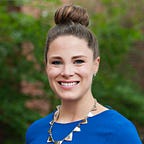Why I Joined Hearken: A Return to What Makes us Human
By Kate Shipley Richey
I’ve been told that jobs are stepping stones — pavers to assist you as you walk the longer path of your career. I’ve found this to be true in many ways, and in my first weeks and months at Hearken I’ve heard tales of winding journeys and varied interests that somehow led the teller to Hearken’s doorstep. And I believe it’s true that experiences lead one-into-the-other like a set of nesting dolls. I think that’s perhaps a closer analogy for my own career experiences, in which each role has uncovered a new truth, a new interest, or a new skill that leads me forward but wouldn’t have been uncovered were it not for the last. Consistent across all of these things, though, is the desire to be heard where I’m working: the desire to be seen in what I’m doing.
At first glance, I suppose, it might seem kind of selfish to join Hearken so that I could be seen, but I think it speaks to the greater purpose that Hearken serves. It’s right there in the name: Hearken means to listen. Hearken is a place that listens and helps others to listen. Hearken knew that I wanted to be heard and seen before I even knew that’s what I wanted, because Hearken believes that human connection is founded upon the human ability to see one another, to hear one another, and to serve one another in times of need. Hearken knew that I needed to be heard in the same way it knows that most people want to be heard. What it’s done for me personally is just a microcosm of what it’s done for the communities and partners it supports. Hearken helps people be heard within their communities and by the organizations that serve them.
I came to Hearken with a background in student engagement, alumni relations, and educational curriculum building and consulting. I had built a fledgling career on teaching, service, and engagement, but I hadn’t yet connected it to a wider philosophy about how we engage as entire communities, as networks. I was firm in my belief that I was a coach, I was a teacher, and I was a supporter, but I couldn’t quite figure out how to apply that beyond my 1:1 interactions.
This struggle could be related to the loneliness I felt as an engagement innovator. Community building is hard work. It takes time and effort, and it requires that you listen to what others have to say, often when what they have to say doesn’t align with what you personally want or think. Community building can be a slow process, and in many of my previous experiences it conflicted with time, resources, and budget that had been promised elsewhere, leaving me standing with an idea that everyone loved but that no one wanted to invest with resources. It was my attempt to streamline community building by digitally connecting large groups of alumni that brought me to a platform called Switchboard, which was a sister company of Hearken that has now merged.
Switchboard is a digital community management system based on the idea that communities and networks of people inherently contain the solutions to the needs within that community — they just need to be connected. For example, a student looking for a job or a place to stay during an internship has a corresponding solution in existence somewhere in the community. Somewhere there is an employer or alum who can solve that need or connect the student to its resolution. The job of Switchboard is to help community managers, or “stewards,” connect those two people so that the community feels supported and needs are met. I was hooked. (I still am hooked.)
I became an evangelist for the concept. I shared it with friends. I shared it with colleagues. I shared it with my peers, and I tried to bring it to my organization. I was fully bought into the idea that people create organic solutions within their communities, especially if their organizations or official networks aren’t solving these problems directly. By providing a tool to help communities leverage these organic solutions, community managers (like I was when I worked in alumni relations) could help the community help itself all while building up connections and relationships. I believed that this was the future of digital engagement. So did Hearken.
I stayed connected to Switchboard as a curious observer and a fan, and when Switchboard and Hearken merged it became clear to me that Hearken’s community listening ethos is the antidote to information overload and digital-technological excess. It is a solid wood table to mass-manufactured plywood. It is a personal conversation to an automated robo-caller.
I joined Hearken because I wanted to be heard, yes, but I also joined Hearken because I believe in the power of helping others be heard, as well. I believe in the power of our communities, in the good that’s being done there. I believe it’s a mistake to overlook what’s local, and I believe that people don’t need as much saving as we think they do. Our communities don’t need unicorn solutions — they need access to the resources and connections that will help them solve problems their own way. This is the work that Hearken does. This is the work that I do.
In my first few months at Hearken, I’ve already had the privilege of completing a project in which we helped a university alumni association expand its network, listen to its members, and reconsider how they serve their alumni community. At the end of it all, one of our partners said of our process: “I felt so seen.”
If I hadn’t already known why I joined Hearken, that was all I needed to hear.
